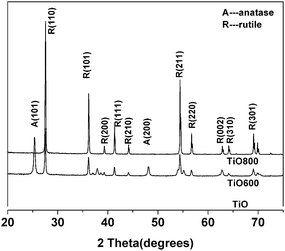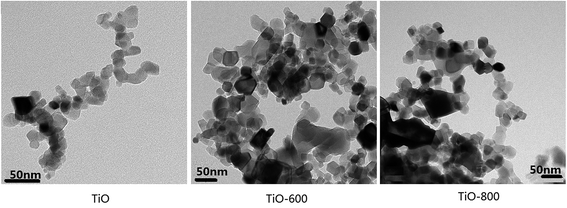Molecular interaction of fibrinogen with thermally modified titanium dioxide nanoparticles
A. S. Zhao,
S. Zhou,
Y. Wang,
J. Chen,
C. R. Ye and
N. Huang*
Key Laboratory of Advanced Materials Technology of Ministry of Education, Department of Materials Science and Engineering, Southwest Jiaotong University, Chengdu 610031, China. E-mail: nhuang@263.net
First published on 22nd August 2014
Abstract
The conformational changes of plasma fibrinogen structures in response to titanium dioxide nanoparticles are critical for determining their toxicity and their influence on blood coagulation. In this study, we combined micro differential scanning calorimetry (DSC), flow cytometry (FACS) and circular dichroism (CD) measurements to monitor the secondary structural changes of fibrinogen on thermally modified nanoparticles and subsequently the blood platelet activation corresponding to the adsorbed fibrinogen. Upon thermal modification, the crystalline phase of the titanium dioxide particles was transformed from anatase to rutile, and more negative charges were generated on them. The modified titanium dioxide particles then induced a loss in α-helical structure of fibrinogen with a decrease in transition enthalpy, which seems to be the highly sensitive structure affected by adsorption. Electrostatic interactions between the heated particles and the αC domains of fibrinogen led to a compact adsorption of proteins onto the particles and then a shielding of the platelet binding sites, which is regarded as an important mechanism to affect the hemocompatibility of the titanium dioxide nanoparticles.
1. Introduction
Nanoparticles (NPs) have specific physicochemical properties that can be widely used in bio-medical fields, such as nano vaccines, image contrast agents and nano drugs, and consequently promote the development of life sciences and materials science. In spite of the remarkable speed of development of nanoscience, our knowledge about the toxicity and biocompatibility of nanomaterials, especially those resulting from interaction between nanomaterials and living matter, is limited. The processes and mechanisms of these interactions are worth further understanding.1When the implanted nanomaterial contacts with the biological environment, protein may interact with NPs to form nanoparticle–protein complexes named the nanoparticle–protein corona (NP–PC).2,3 The composition and conformation of the adsorbed proteins of NP–PC have significant impacts on the overall biological responses induced by NPs. These biological responses usually involve cell attachment, cellular signaling and blood coagulation.
Human plasma contains lots of proteins which can be adsorbed onto NPs such as human plasma fibrinogen (HPF), human serum albumin (HSA) and globulins. Therefore, for NPs like carbon nanotubes (CNTs) and titanium dioxide nanoparticles, evaluation of plasma protein adsorption is a key element to determine their potential applications in medicine and diagnosis process.4–6
HPF (340 kDa) is a multidomain protein. It takes part in inflammation reactions following implantation of prosthesis7 and the coagulation process of NPs.8 The polypeptide chains of fibrinogen comprise three spherical regions (αC, D and E domain) connected by two narrow rods.9 HPF has a net negative charge in physiological condition. Negatively charged residues always spread on the E and D domains. The αC domain with many positive charges attaches to the D and E domains by the Arg and Lys residues.10 It is generally accepted that there are many specific epitopes on these domains to balance the coagulation reaction. For examples, the peptide sequence 400–411 of the gamma chain of fibrinogen binds to the IIb/IIIa receptor in platelets and the Arg-16-Gly-17 of the Aα-chain is sensitive to thrombin.11
When fibrinogen is adsorbed onto the NPs surface, exposure of the specific epitopes induced by the surface-driven conformational changes in fibrinogen can affect the hemocompatibility of the NPs.12–14 The molecular mechanism behind fibrinogen adsorption, however, is still unclear and a subject of controversial discussion. Spectroscopic analysis reveals that the secondary structure of fibrinogen (such as α helices, β sheets and coils) changes along with the different physicochemical properties of the NPs. For example, the conformation of fibrinogen changes from side-on to end-on with the increasing size of the gold nanoparticles, which can result in protein unfolding and cell attachment.15
Nanometric titanium dioxide is a promising material in drug delivery.16 The protein–nano interface plays a critical role in determining its final fate and medical efficacy. So here, we report the interaction of HPF with three different types of titanium dioxide particles modified by thermal. The study aims to elucidate how the physicochemical determinants of the nanometric titanium dioxide particles influence the adsorption of fibrinogen, and the relationship between the surface-driven conformational changes of fibrinogen and the hemocompatibility of nanometric titanium dioxide.
2. Material and methods
2.1. Materials
Nanometric titanium(IV) dioxide (99.99% pure, p25) powder was purchased from Sigma-Aldrich (Germany Lot no. MKBG9739V) with a crystal structure of approximately 80% anatase and 20% rutile. Particle diameters were between 20 and 40 nm.Human plasma fibrinogen (HPF) was obtained from Sigma Chemical Co (Lot no. F3879). The protein was dissolved in phosphate buffered saline (PBS, pH 7.4, Gibco) and stored at 4 °C. Other chemicals used were ACS grade.
Human citrate anticoagulated whole blood was taken from healthy donors after informed consent. The fresh blood was centrifuged at 1500 rpm for 15 min and the supernatant was harvested as rich platelet plasma (PRP).17
2.2. Methods
2.3. Surface analysis
To better recognize the surface changes occurring after the thermal treatment, all samples were analyzed by X-ray diffraction (XRD, X'Pert Pro MPD) to identify the phase and crystal structure of titanium dioxide particles before and after annealing. The scanning range of 2θ was 20°–60°. X-ray photoelectric spectroscopy (XPS) was applied to characterize the composition and bonding structure of the particles. Transmission electron microscope (TEM) and dynamic light scattering (DLS) were applied to observe the size and morphology of particles. The electrophoretic mobility of the particles was measured to determine their zeta potential.2.4. Titanium dioxide–protein interaction
All samples were exposed to HPF at conditions indicated below. The control group is 4 mg ml−1 HPF in solution. The conformation change of HPF in solution (control group) and adsorbed on particles was identified by circular dichroism (CD) and differential scanning calorimetry (DSC) measurements.2.5. Titanium dioxide–blood interaction
All titanium dioxide samples were reacted with PRP. The blank control is pure PRP without contacting with any particles. The activation of platelets was determined by Flow Cytometry (FACS, BECKMAN COULTER).3. Results
We firstly studied the influence of heating on the physicochemical properties of titanium dioxide particles. As shown in Fig. 1, XRD spectra displayed that the crystalline phase of control particles was composed of rutile and anatase. Heating reduced the percentage of anatase and at 800 °C all the crystalline phase was transferred to rutile. We then observed the morphology and size of particles. As shown in Fig. 2, though the size of particles remained around 20–40 nm without obvious change, their morphology was changed from the typically spherical shape in the control particles to more rod-shape in the heated ones. Finally, we found that the zeta potential of samples was altered by heating treatment. More negative charge (−24 and −40 mV, respectively) was appeared following the heat treatment (shown in Table 1).The average surface composition of the titanium dioxide particles was checked with XPS. Fig. 3 shows the typical spectrum for titanium dioxide in all cases with Ti 2p and O 1s core spectra of the particles presented Fig. 3. Two main peaks located at 459.1 and 464.8 eV in all the Ti 2p spectra (Fig. 3a), are associated with Ti4+ 2p 3/2 and Ti4+ 2p 1/2 23 respectively. The minor peak at lower binding energy 457.3 eV is assigned to Ti3+ 2p 3/2b23,24 and likely due to oxygen vacancy induced by heating.25 Fig. 3b shows higher resolving O 1s spectra for two heated titanium dioxide particles. The main peak centered at 530.3 eV in the O 1s spectra is related with the bulk oxygen in titanium dioxide which appeared in all the samples. Two peaks located 531.4 and 532.5 eV were also observed in the annealed films. The former can be corresponded to the acidic hydroxyl groups (Ti–OH(a)) and physically adsorbed H2O in the Ti–O structure. The latter has commonly suggested surface basic hydroxyl groups, Ti–OH(b).26,27 A comparison of the intensity of the Ti–OH(b) peak for the control and heat-treated samples shows that heat treatment renders titanium dioxide nanoparticles a higher concentration of basic hydroxyl groups. With the increased heating temperature of the particles, higher Ti–OH(b) peak intensities were observed.
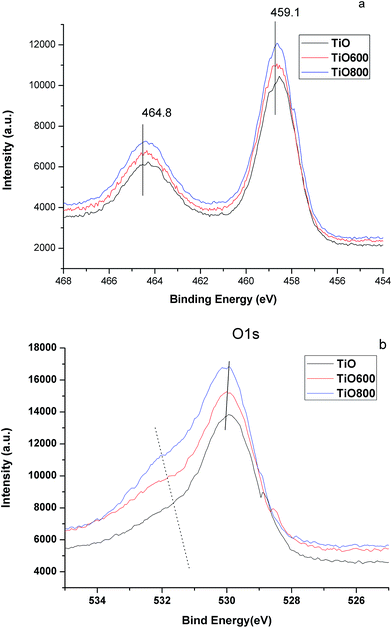 | ||
| Fig. 3 XPS spectrum of surfaces of titanium dioxide powder and heating modified titanium dioxide powder: (a) Ti 2p XPS spectrum and (b) O 1 s XPS spectrum. | ||
Next, we analyzed the secondary structure changes of fibrinogen on titanium dioxide nanoparticles with different heating manufacture and CD spectrometry was applied since it is known to be a most sensitive spectroscopic technique to monitoring protein structure in solution or adsorbed to other molecules/particles28,29 (Fig. 4). The secondary structure components were calculated using the CDNN software30 (Fig. 5). As shown in Fig. 4, native fibrinogen produced two negative bands at 209 and 220 nm in the CD spectra representing its typical characterization of the α-helix structure.28 There was increased intensity of ellipticity at 209 and 220 nm, normally indicating the reduced α-helix content. Upon adsorbed onto the NPs, fibrinogen obviously decreased its content of α-helix and mainly transformed helix into random coils and β-pleated sheets, while the β-turn contents showed little variation, indicating that the fibrinogen conformation changed dramatically. These conformational changes of the secondary structure of fibrinogen was still dramatic when it adsorbed onto the titanium dioxide powder heated at 600 °C with a significant decrease in the α-helix content (from 39.6% to 27.1%). Noticeably, the CD spectra of the protein adsorbed onto the 800 °C heated titanium dioxide powder was almost identical with its physiological state. Since a higher percentage of random coil structure of a protein often indicates a lower intermolecular interactions and a looser conformation.31 We concluded that fibrinogen had more random coil structure and lost its compact structure when adsorbed on the native titanium dioxide and the 600 °C heated titanium dioxide powder.
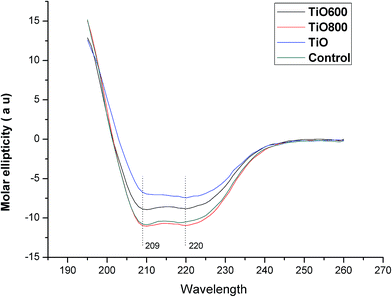 | ||
| Fig. 4 The CD spectra changes of fibrinogen in solution (control group) and adsorbed on titanium dioxide particles. | ||
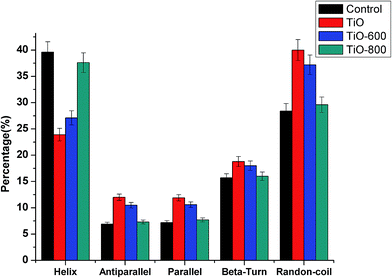 | ||
| Fig. 5 The estimated secondary structure components of fibrinogen in solution (control group) and adsorbed fibrinogen on titanium dioxide particles (means ± standard deviation). | ||
To further assess the conformational changes of fibrinogen, we used differential scanning calorimetry to analyze how the thermal stability of fibrinogen was altered by biomaterial (Fig. 6 and Table 2). As shown in Fig. 6, two transition peaks (Tm) at 53 °C and 94 °C with enthalpies (ΔH) of 2562 and 1056 kJ mol−1 are observed for the fibrinogen in native state which were in good consistent with the data reported by Medved.32 According to Medved, at 53 °C the end domain D of fibrinogen unfolds and loses its second structure, while the peak at 94 °C is attributed to the denaturation of middle domain E. A decrease in enthalpy along with lower transition temperature indicates some kind of denaturation happened on proteins. When adsorbed onto the particles, fibrinogen showed a strong exothermic aggregation peak at high temperature and the transition corresponding to domains E did not exist. Despite this aggregation, the transition peak of the lower temperature domain corresponding to domain D was still observed. The Tm of the adsorbed fibrinogen was shifted to a lower temperature and the low-temperature transition enthalpy of adsorbed protein on particles was decreased compared with the native one (2562 kcal mol−1). Titanium dioxide either in the native state or annealed at 600 °C significantly perturbed the low-temperature transition enthalpy of adsorbed fibrinogen (1478 kcal mol−1 and 1527 kcal mol−1, respectively), indicating an unfolding stated of D domain exists in the adsorbed fibrinogen. However, after annealed at 800 °C, the particles showed a little effect on the conformation of D domain, and the transition enthalpy of the adsorbed protein (2500 kcal mol−1) was similar with the native one.
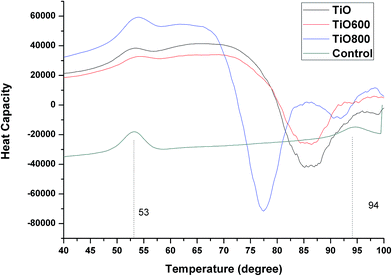 | ||
| Fig. 6 Thermal stability of fibrinogen dissolved in PBS (pH 7.4, c = 4 mg ml−1; m = 3.2 mg) and adsorbed onto titanium dioxide particles (1 mg protein per mg particles). | ||
| Tm (°C) | ΔHcalm (kJ mol−1) | Tm (°C) | ΔHcalm (kJ mol−1) | |
|---|---|---|---|---|
| a Samples performed in triplicate (means ± standard deviation). | ||||
| Native | 53.1 ± 0.6 | 2562 ± 10.5 | 94.4 ± 0.2 | 1056 ± 12 |
| Adsorbed on TiO | 52.8 ± 0.3 | 1478 ± 8.3 | 95.1 ± 0.4 | — |
| Adsorbed on TiO-600 | 52.8 ± 0.4 | 1527 ± 7.2 | 94.9 ± 0.5 | — |
| Adsorbed on TiO-800 | 53.0 ± 0.6 | 2500 ± 8.2 | 97.5 ± 0.6 | — |
Finally, we innovatively and successfully applied FACS to check the direct and multiple interactions between nanometric titanium dioxide particles and blood plasma in situ. FACS is a well-establish technique for simultaneous identification and separation of up to thousands of microscopic particles, such as chromosomes and cells per second. It has broad applications in cell sorting, cell cycle, surface antigen identification and subcellular structure analysis.33,34 As shown in Fig. 7, nanometric titanium dioxide induced the platelet activation marking with the exposure of the integrin CD62 on the platelets. Compared with the control blank plasma, both the titanium dioxide and the 600 °C annealed titanium dioxide significantly increased the CD62 expression on the platelets. While the 800 °C annealing can improve the blood compatibility of the titanium dioxide particles and induce less platelet activation.
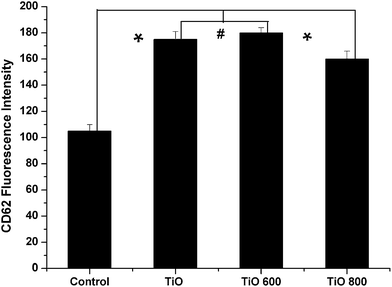 | ||
| Fig. 7 Platelet surface average fluorescence intensity after interacted with particles (# p > 0.05, * p < 0.05). | ||
4. Discussion
The thermal treatment of titanium dioxide results in an alteration of interfacial potential at pH 7.4, as well as a marked change of the crystalline phase. Heating treatment in various environments can affect the stoichiometry and structure of the particle surfaces. Annealing under vacuum induces phase transformation from anatase to rutile. These treatments may cause lattice imperfections and the missing rows of bridging oxygen ions are the most common.35–38 Thermal removal of surface hydroxyls affects the particle zeta potential and isoelectric point.39 Annealing will removal of physically adsorbed H2O and induce a large fraction of oxygen defects within the TiO2−x structure causing those particles to become substoichiometric particles which will adsorb and dissociate water molecule to form basic hydroxyl groups, Ti–OH(b). It can explain our finding that the zeta potential of the heated samples was more negative than the control powders in an aqueous solution at physiologic pH (7.4).The general and main driving forces for protein adsorption are hydrophobic interaction and electrostatic attraction, depending on the physical and chemical properties of the material surface.40 Our results are consistent with this mechanism and suggest that electrostatic interaction may be the dominative interaction between fibrinogen and the hydrophilic TiO2 surfaces. Titanium dioxide has amphoteric properties, which allow it to react as acid towards strong bases or as base towards strong acids.41,42
In the aqueous solutions, two kinds of surface hydroxyl groups may contribute to the amphoterism of titanium dioxide. One is acidic hydroxyl groups (Ti–OH(a)) and the other is basic hydroxyl groups (Ti–OH(b)).43 The fibrinogen is also an amphoteric molecular whose individual domains and subdomains have different net charges, even though the global fibrinogen molecule has a negative net charge at pH 7. The aC domain of fibrinogen is positive because it is composed of rich arginine and lysine while the E and D domains are negative 10. Therefore, the surfaces of titanium dioxide retains electrostatic interactions between Ti–OH(b) and aC domain as well as E and D domains with Ti–OH(a).
The electrostatic interaction can induce the secondary structure changes of fibrinogen. Chengyongli21 studied the adsorption of fibrinogen onto hydroxyapatite and titanium oxide nanoparticles. Their CD measurements revealed that the helical content in the adsorbed fibrinogen decreased along with an entropy gain as a result of adsorption-induced rearrangements. Natascha Brandes44 reported that the α-helical appeared to be the most sensitive structure to affect the thermal stability of fibrinogen. Fragment D and E contain 50% α-helical and 35% α-helix, respectively.45 Our results are in good agreement with others; the percentages of α-helix of fibrinogens adsorbed onto titanium dioxide and titanium dioxide heated at 600 °C/800 °C were 23.9%, 27.1% and 37.6%, respectively. The above data show that the CD spectra of adsorbed fibrinogen on 800 °C heated titanium dioxide were quite similar to those of native fibrinogen. Therefore, the structural changes of fibrinogen upon adsorption on the 800 °C heated titanium dioxide are small. The DSC measurements of fibrinogen adsorbed on titanium also indicated the α-helix decrease obtained for the HPF/heated titanium dioxide system was accompanied by a decrease in denaturation enthalpy for the D-domain due to adsorption. These results are similar to those of Natascha Brandes44 who studied FBG adsorption onto ceramic particles. Compared to the native titanium, a smaller structural loss was obtained for the 800 °C heated titanium dioxide–protein systems. This may be explained by more negative charges of the heated sample, which interact with the αC domain but not D and E domain and therefore induce only little conformational structure change.
Fibrinogen is a key protein responsible for thrombosis formation, inflammatory response and other foreign body reaction involved in interaction between biomaterial and blood. There are two active sites, the dodecapeptide (c400–411) and the RGDS sequence (Aα572–575) which has been implicated to play a critical role in the mediating platelets binding with fibrinogen.45 In the native state, these active sites are located in the D-domain of the gamma chain and shielded by the αC domain to hinder platelet binding.
It is also known that adsorption of fibrinogen on various surfaces may change the conformation of fibrinogen. Sibel Tunc used specific enzyme-linked immunosorption experiments, AFM and FTIR to observe fibrinogen conformational change when adsorbed on Si surface and found that fibrinogen adsorbed on hydrophobic surface with trinodular shape and on hydrophilic surface with globular shape.46 When fibrinogen interacts with hydrophilic surface, the “αC-connector” flexible segment (Aα221–391) is thought to be the most surface active domain due to its hydrophicity.47 Seung, Y. J.47 reported that in neutral environment the fibrinogen showed side-on adsorption on silica by means of the electrostatic bonding between αC domains with surface. In our case of titanium dioxide 800 °C heated powder with more negative charge, the fibrinogen had the similar tendency to contact with material via the positively charged αC domains.
Thus, the rest of the molecule resides (domains E and D) with negative charge were screened and were not in direct contact with surface. The exposure chance of the platelet binding site on D-domain is less than in the control group with less negative charges. This speculation was also confirmed by introduction platelet rich plasma to the adsorbed protein layers. The results of flow cytometry showed that platelets on the 800 °C heated titanium dioxide exhibited less aggregation and activation, compared to the native titanium dioxide surface.
5. Conclusions
The molecular stability and functional changes of fibrinogen play a critical role in determining the application safety and therapeutic efficacy of nanoparticles. The properties of nanoparticles such as particle size, chemical composition and crystal structure can affect their interactions with fibrinogen and induced structural arrangement of fibrinogen. In the present study, various interface tools CD, DSC and FACS were combined to monitor the adsorption-induced conformational changes of fibrinogen and blood platelets activation on the thermal modified titanium dioxide particles in situ. High sensitive CD and calorimetric measurements clearly indicated severe structural changes of fibrinogen in adsorbed state. The α-helix content of fibrinogen molecules was decreased significantly when contacting with nanoparticles with a high decrease in transition enthalpy. The properties of the sorbent surface can affect the extent of the fibrinogen conformation rearrangements. For the hydrophilic titanium dioxide surface, electrostatic interactions can attract the fibrinogen to form a compact conformation and prevent the exposure of platelet binding sites to some degree which constitutes the main mechanism to affect the hemocompatibility of titanium dioxide particles.Acknowledgements
This study was supported by National Natural Science Foundation of China (no. 9732011CB606200, 81330031 and 31170916). The authors gratefully acknowledge assistance of Dr Manfred Maitz and professor yupingchen.Notes and references
- S. R. Saptarshi, A. Dusch and A. L. Lopata, et al., J. Nanobiotechnol., 2013, 11–26 Search PubMed.
- E. Casals, T. Pfalle and A. Duschl, et al., ACS Nano, 2010, 4, 3623–3632 CrossRef CAS PubMed.
- T. Cedervall, I. Lynch and M. Foy, et al., Angew. Chem., Int. Ed., 2007, 46, 5754–5756 CrossRef CAS PubMed.
- R. J. Chen, S. Bangsaruntip and K. A. Drouvalakis, et al., Proc. Natl. Acad. Sci. U. S. A., 2003, 100(9), 4984–4989 CrossRef CAS PubMed.
- Z. J. Deng, M. Liang and M. Monteiro, et al., Nat. Nanotechnol., 2011, 6(1), 39–44 CrossRef CAS PubMed.
- M. Lundqvist, J. Stigler and G. Elia, et al., Proc. Natl. Acad. Sci. U. S. A., 2008, 105(38), 14265–14270 CrossRef CAS PubMed.
- C. J. Wilson, R. E. Clegg and D. I. Leavesley, et al., Tissue Eng., 2005, 11(1–2), 1–18 CrossRef CAS PubMed.
- P. P. Kamali and D. Simberg, Expert Opin. Drug Delivery, 2011, 8, 343–357 CrossRef PubMed.
- K. Marek, T. Sheila, J. L. Thomas and H. Jacek, Biochemistry, 1984, 23(8), 1767–1774 CrossRef.
- T. A. Horbett and J. L. Brash, Proteins at Interfaces II, American Chemical Society, Washington, DC, 1995 Search PubMed.
- R. W. Colman, J. Hirsh and V. J. Marder, et al., Basic Principles and Clinical Practice, Lippincott Williams and Wilkins, Philadelphia, 4th edn, 2001, pp. 203–232 Search PubMed.
- A. Alexandre, S. T. Peter and C. W. Warren, et al., Biomed. Eng., 2012, 14, 1–16 Search PubMed.
- Z. J. Deng, M. Liang and M. Monteiro, et al., Nat. Nanotechnol., 2011, 6(1), 39–44 CrossRef CAS PubMed.
- W. Chao and L. Ying, Sci. Total Environ., 2012, 429, 156–160 CrossRef PubMed.
- J. Deng, M. Sun and J. Zhu, et al., Nanoscale, 2013, 5, 8130–8137 RSC.
- H. Liu and T. J. Webster, Biomaterials, 2007, 28, 354–369 CrossRef CAS PubMed.
- H. Ichiro, M. Eriko and T. Yukinobu, et al., Tissue Eng., Part A, 2014, 20(3), 874–882 Search PubMed.
- D. E. MacDonald, B. Markovic and A. L. Boskey, et al., Colloids Surf., B, 1998, 11(3), 131–139 CrossRef CAS.
- A. Kondo and H. Fukada, J. Colloid Interface Sci., 1998, 198, 34–41 CrossRef CAS.
- P. L. Privalov, Pure Appl. Chem., 1980, 479, 52–55 Search PubMed.
- C. Yongli, Z. Xiufang and G. Yandao, et al., J. Colloid Interface Sci., 1999, 214, 38–45 CrossRef CAS PubMed.
- C. L. Berman, E. L. Yeo and J. D. Wencel-Drake, et al., J. Clin. Invest., 1986, 78, 130–136 CrossRef CAS PubMed.
- B. Demri, M. Hage-Ali and M. Moritz, et al., Appl. Surf. Sci., 1997, 108, 245–249 CrossRef CAS.
- L. T. Hudson, R. L. Kurtz and S. W. Robey, et al., Phys. Rev., 1993, 47, 1174–1177 CAS.
- S. Hashimoto, A. Tanaka and A. Murata, et al., Surf. Sci., 2004, 556, 22–32 CrossRef CAS PubMed.
- K. E. Healy and P. Ducheyne, Biomaterials, 1992, 13, 553–561 CrossRef CAS.
- T. K. Sham and M. S. Lazarus, Chem. Phys. Lett., 1979, 68, 426–432 CrossRef CAS.
- L. Trynda Lemiesz, A. Karaczyn and B. K. Keppler, et al., J. Inorg. Biochem., 2000, 78(4), 341–346 CrossRef CAS.
- R. Lakshminarayanan, I. Yoon and B. G. Hegde, et al., Proteins, 2009, 76(3), 560–569 CrossRef CAS PubMed.
- J. G. Norma, Nat. Protoc., 2006, 1(6), 2876–2890 Search PubMed.
- J. S. Lorna, M. F. Klaus and S. Harald, et al., Folding Des., 1996, 5(1), 95–106 Search PubMed.
- L. V. Medved, S. V. Litvinovich and P. L. Privalov, FEBS Lett., 1986, 202(2), 298–302 CrossRef CAS.
- A. D. Michelson, M. R. Barnard and L. A. Krueger, Methods, 2000, 21(3), 259–270 CrossRef CAS PubMed.
- P. Rajbabu and W. Ron, Cardiovasc. Revasc. Med., 2011, 12(5), 312–322 CrossRef PubMed.
- M. Sander and T. Engel, Surf. Sci., 1994, 302, 263–268 CrossRef.
- D. Novak, E. Garfunkel and T. Gustafsson, Phys. Rev. B: Condens. Matter Mater. Phys., 1994, 50, 5000–5003 CrossRef CAS.
- A. Szabo and T. Engel, Surf. Sci., 1995, 329, 241–254 CrossRef CAS.
- Q. Guo, I. Cocks and E. M. Williams, Phys. Rev. Lett., 1996, 77, 3851–3854 CrossRef CAS.
- A. Abdulwahabs and A. Yaserm, J. Dispersion Sci. Technol., 2012, 33(5), 728–738 CrossRef.
- W. Norde, Adv. Colloid Interface Sci., 1986, 25, 267–340 CrossRef CAS.
- H. x P. Boehm, Discuss. Faraday Soc., 1971, 52, 264–275 RSC.
- G. A. Parks, Chem. Rev., 1965, 65, 177–198 CrossRef CAS.
- D. Ulrike, The Surface Science of Titanium Dioxide Surface Science Reports, 2003, vol. 48, 53–229 Search PubMed.
- B. Natascha, B. Petra and B. Welzel, et al., J. Colloid Interface Sci., 2006, 299, 56–69 CrossRef PubMed.
- H. Natalia, R. S. Leandro and R. I. Barbosa, et al., J. Colloid Interface Sci., 2011, 362, 118–126 CrossRef PubMed.
- T. A. Springer, J. Zhu and T. Xiao, J. Cell Biol., 2008, 182(4), 791–800 CrossRef CAS PubMed.
- Y. J. Seung, M. L. Soon and A. Fernando, et al., J. Am. Chem. Soc., 2003, 125(42), 12782–12786 CrossRef PubMed.
| This journal is © The Royal Society of Chemistry 2014 |

